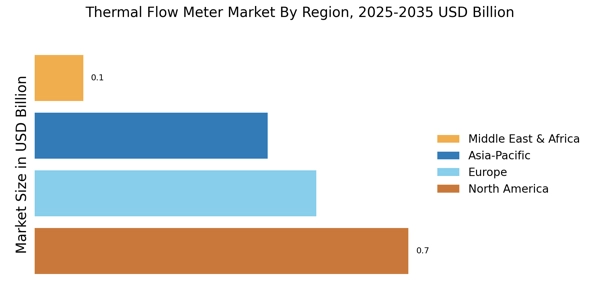Expansion of Industrial Applications
The Thermal Flow Meter Market is witnessing an expansion in its application areas, driven by the diverse needs of various industries. Beyond traditional sectors such as oil and gas, thermal flow meters are increasingly being utilized in food and beverage, pharmaceuticals, and chemical processing industries. This diversification is largely attributed to the versatility of thermal flow meters, which can be adapted for different fluids and conditions. The market is projected to see a surge in demand as industries recognize the benefits of using thermal flow meters for process optimization and quality control. Furthermore, the ability of these meters to operate effectively in challenging environments enhances their appeal across multiple sectors. As industries continue to explore new applications for thermal flow meters, the market is likely to experience sustained growth.
Increasing Focus on Energy Management
The Thermal Flow Meter Market is benefiting from a growing emphasis on energy management and sustainability practices. As organizations strive to reduce their carbon footprint and improve energy efficiency, the demand for thermal flow meters is on the rise. These devices play a crucial role in monitoring and managing energy consumption, particularly in industrial applications where energy costs can be substantial. Recent studies indicate that effective energy management can lead to savings of up to 30% in operational costs. Consequently, industries are increasingly investing in thermal flow meters to gain insights into their energy usage patterns. This trend is expected to continue, as regulatory pressures and consumer expectations for sustainability drive companies to adopt more efficient technologies. The focus on energy management is likely to propel the growth of the thermal flow meter market.
Rising Demand for Accurate Measurement
The Thermal Flow Meter Market is experiencing a notable increase in demand for precise flow measurement solutions across various sectors. Industries such as oil and gas, water treatment, and HVAC are increasingly relying on thermal flow meters for their ability to provide accurate readings under varying conditions. According to recent data, the market for thermal flow meters is projected to grow at a compound annual growth rate of approximately 6.5% over the next few years. This growth is driven by the need for enhanced operational efficiency and reduced wastage, as companies seek to optimize their processes. The ability of thermal flow meters to measure low flow rates with high accuracy makes them particularly appealing in applications where precision is paramount. As industries continue to prioritize accuracy, the demand for thermal flow meters is likely to rise.
Regulatory Compliance and Safety Standards
The Thermal Flow Meter Market is significantly influenced by the increasing regulatory compliance and safety standards across various sectors. Governments and regulatory bodies are implementing stringent guidelines to ensure safety and efficiency in industrial operations. Thermal flow meters are essential tools for meeting these regulations, as they provide accurate flow measurements that are critical for compliance. Industries such as pharmaceuticals and food processing are particularly affected, as they must adhere to strict quality and safety standards. The demand for thermal flow meters is expected to rise as companies seek to ensure compliance with these regulations while maintaining operational efficiency. This trend highlights the importance of thermal flow meters in not only enhancing safety but also in supporting industries in meeting their regulatory obligations.
Technological Advancements in Flow Measurement
Technological innovations are significantly influencing the Thermal Flow Meter Market, leading to the development of advanced flow measurement solutions. The integration of digital technologies, such as IoT and AI, is enhancing the functionality of thermal flow meters, allowing for real-time data analysis and remote monitoring. These advancements not only improve measurement accuracy but also facilitate predictive maintenance, thereby reducing downtime. The market is witnessing a shift towards smart thermal flow meters that can communicate with other devices and systems, providing a more comprehensive view of operational performance. This trend is expected to drive market growth, as industries increasingly adopt these sophisticated solutions to enhance their operational capabilities. The ongoing evolution of technology in flow measurement is likely to create new opportunities for manufacturers and end-users alike.


















Leave a Comment